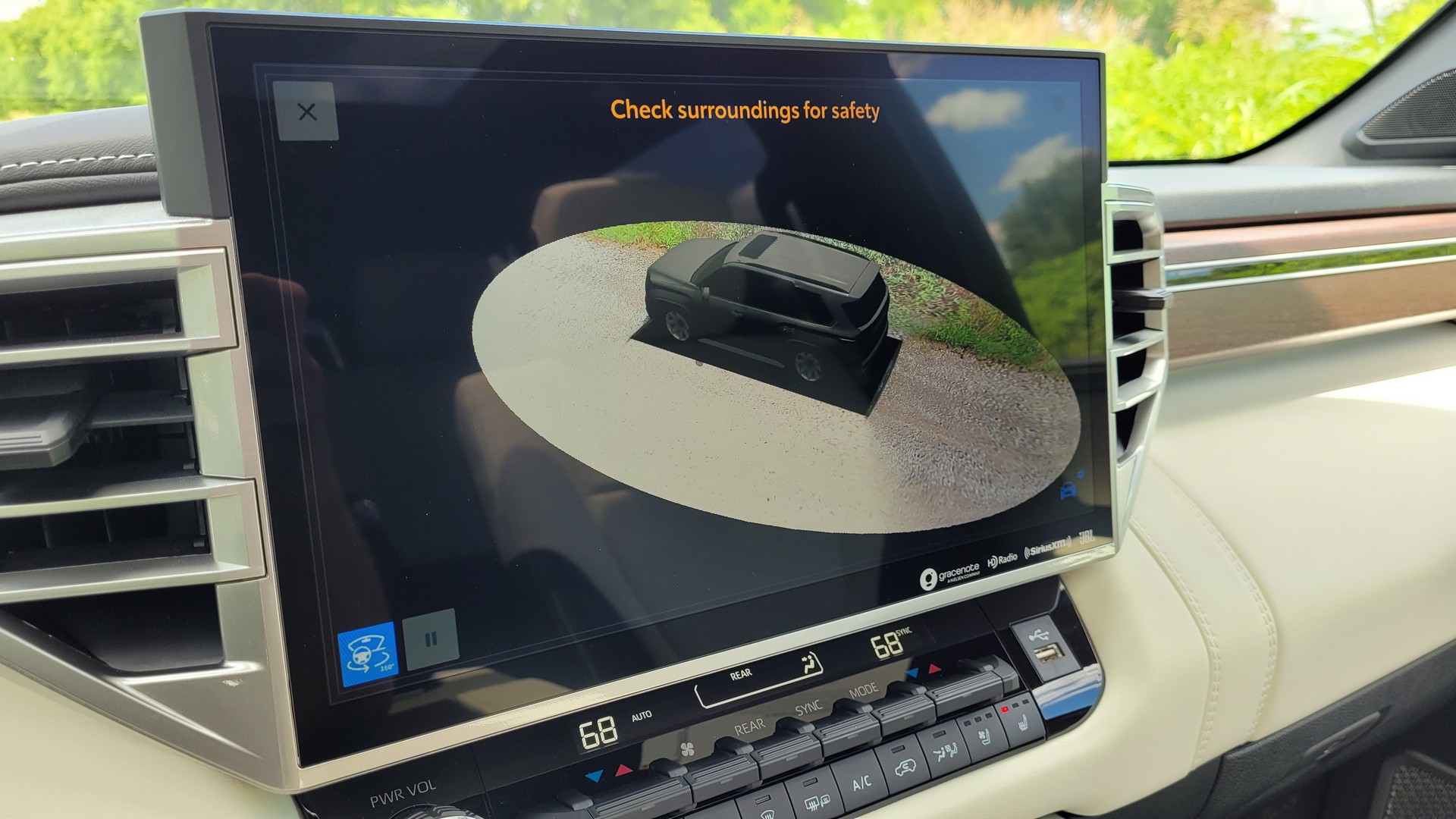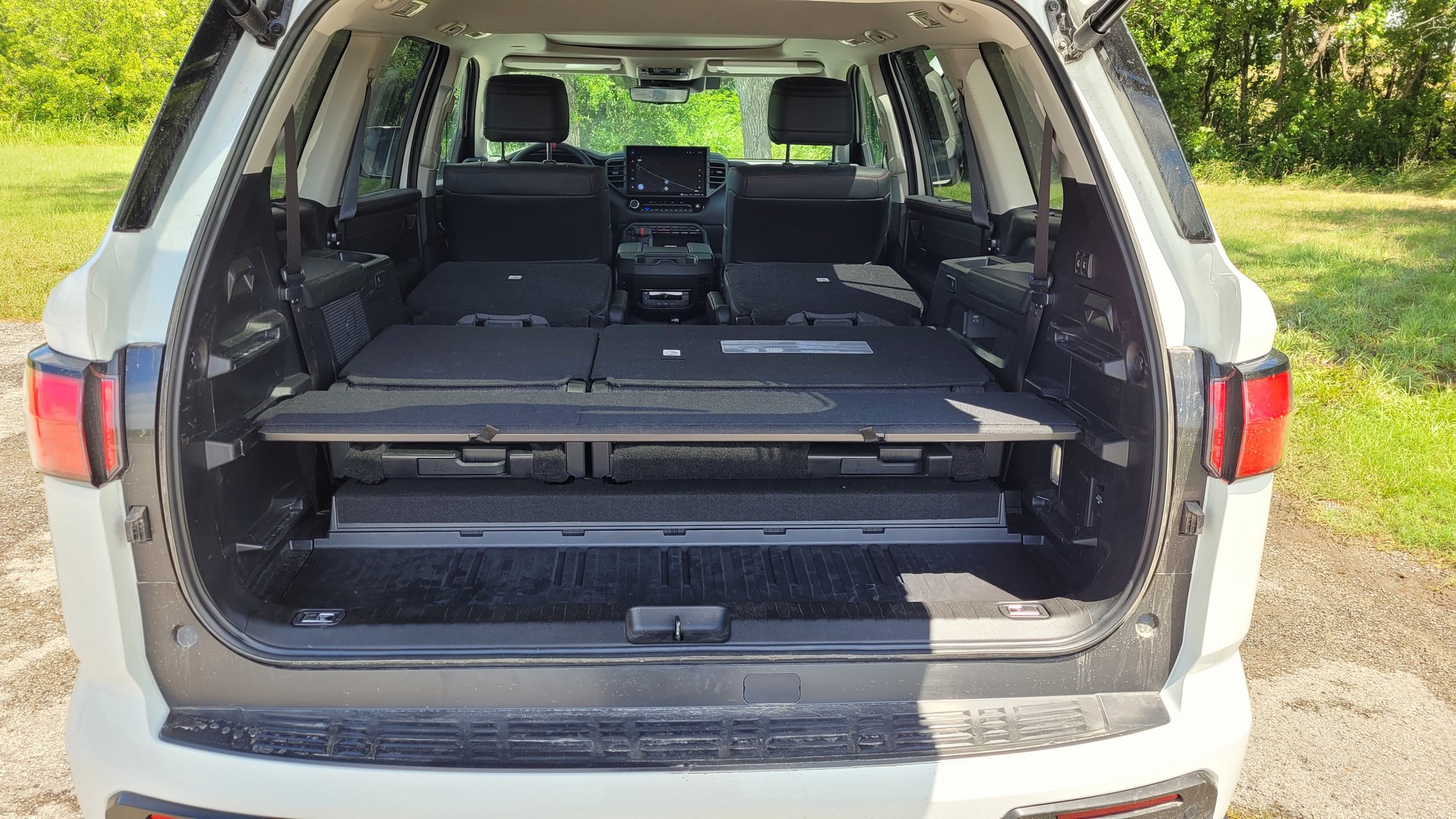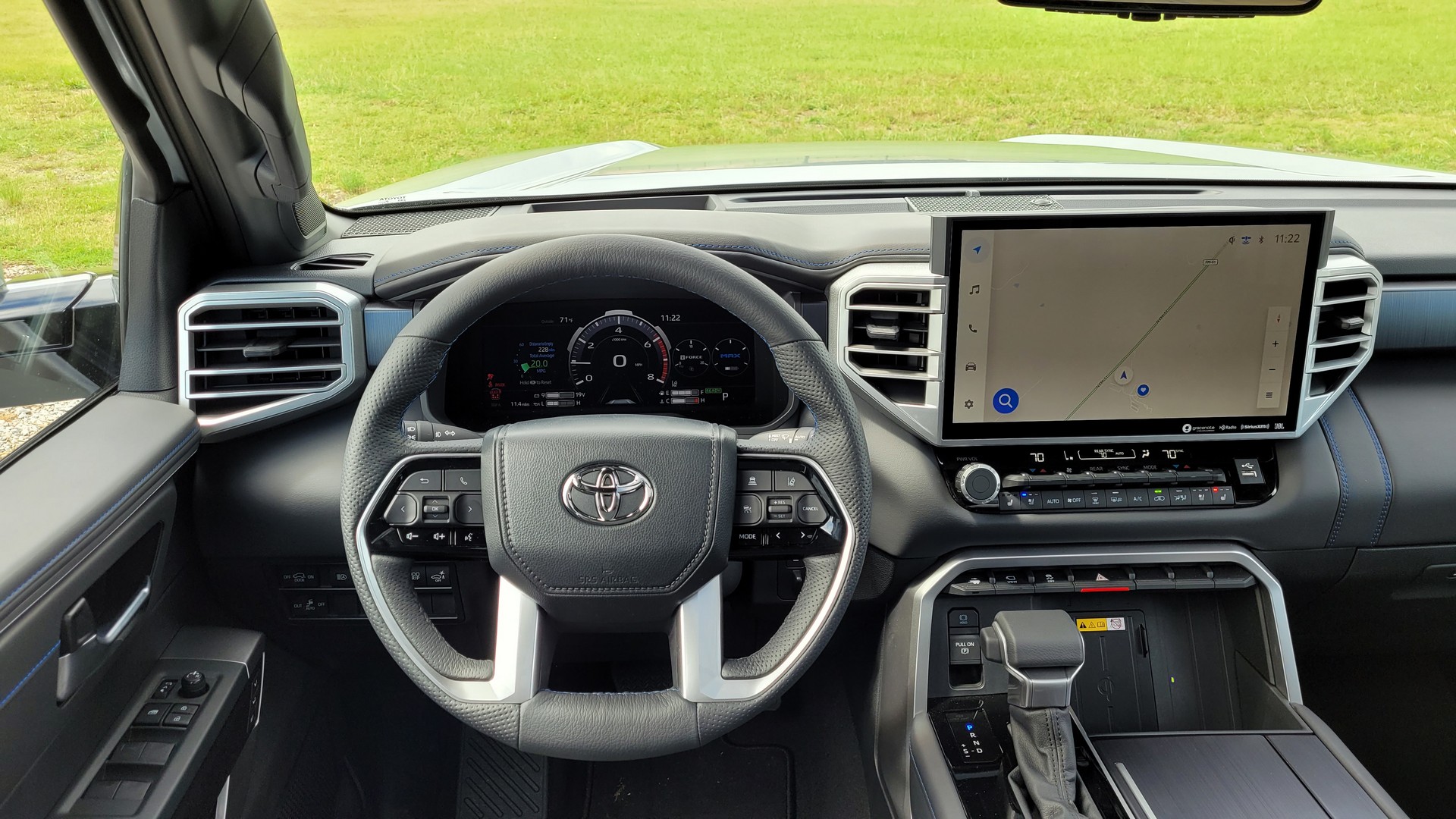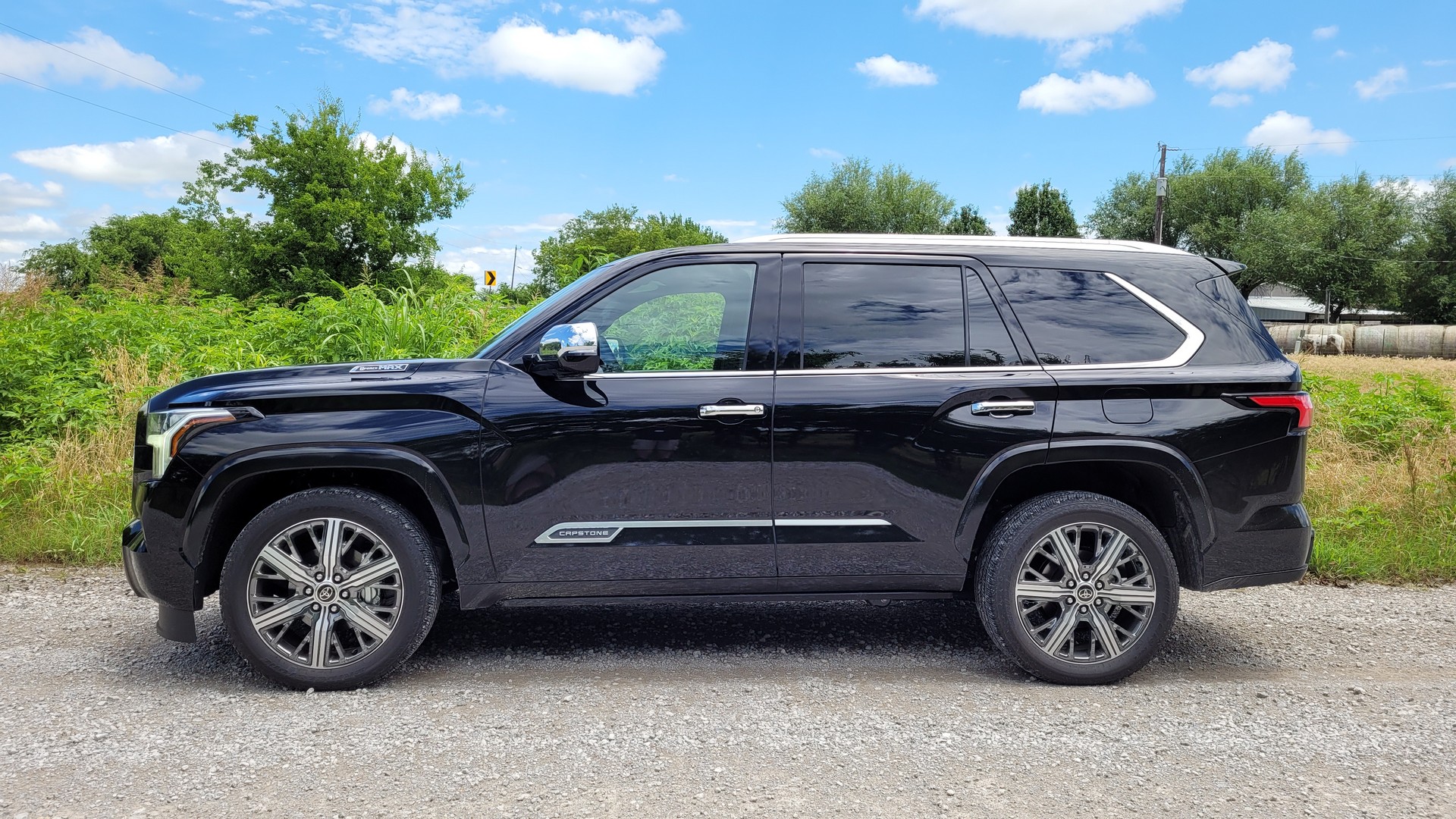Fifteen years is an eternity in the automotive world, but that’s how much time has passed between the introduction of the second- and third-generation Toyota Sequoia.
Introduced at the 2007 Los Angeles Auto Show, the second-generation Sequoia debuted a few months after the original Apple iPhone. However, it failed to have a lasting legacy as the model quickly faded into obscurity.
Despite meager sales, Toyota isn’t throwing in the towel as the 2023 Sequoia combines bold styling with a high-tech interior and a hybrid powertrain. While these features should make rivals from Detroit nervous, the company didn’t exactly hit a home run.
A Bold, Modern Exterior
Quick Facts › › ›
› Model: 2023 Toyota Sequoia
› MSRP: $58,300
› Powertrain: 3.5-liter Twin-Turbo Hybrid V6 / 10-Speed Auto / RWD or 4WD
› Output: 437 hp (326 kW / 443 PS) & 583 lb-ft (790 Nm)
› On Sale: Summer
One look at the 2023 Sequoia reveals Toyota means business as the SUV adopts an edgy design that incorporates a number of cues from the Tundra. This is immediately apparent up front as there’s a massive grille that is flanked by T-shaped LED headlights. While those components closely echo the pickup, the SUV features a unique front bumper that looks arguably better than the one used on the truck.
Moving further back, there’s chiseled fenders and taut bodywork for a more muscular appearance. They’re joined by blacked out pillars, which help to give the model a continuous looking greenhouse. Buyers will also find an assortment of stylish wheels ranging in sizes from 18- to 22-inches.
The modern design continues out back with a new liftgate that features an old-school flip-up rear window. Further below, there’s a minimalist bumper and slender LED taillights with available sequential turn signals.
The 2023 Sequoia is 3 inches (76 mm) longer than its predecessor, but its 208.1 inch (5,286 mm) length still comes up short when compared to the Chevrolet Tahoe, Ford Expedition, and Jeep Wagoneer. However, its 122 inch (3,099 mm) wheelbase slots between rivals as it’s slightly more generous than the Tahoe.
A High-Tech Cabin That Ranges From Basic To Plush
While we had mixed feelings about the Tundra’s cabin, the Sequoia’s interior feels more competitive despite largely carrying over from the pickup. Once inside, drivers will find a 12.3-inch digital instrument cluster and a 14-inch Toyota Audio Multimedia system on everything except the entry-level SR5, which uses a smaller 8-inch display.
The infotainment system debuted on the Tundra and is a huge improvement over the previous 7-inch display, which was the equivalent of a flip phone in an iPhone world. The voice-focused infotainment system features an Intelligent Assistant, which responds to the “Hey Toyota” wake word and can be used to adjust climate and audio settings, enter destinations, and find nearby points of interest such as gas stations or restaurants using Google data.
The features don’t end there as the system boasts wireless Apple CarPlay and Android Auto compatibility, cloud-based navigation, over-the-air updates, and integrated Apple Music and Amazon Music streaming. However, many of these features require a subscription after the trial period expires.
Putting the infotainment system aside, the 2023 Sequoia comes nicely equipped as even the entry-level SR5 features eight-way power heated front seats, a moonroof, and an auto-dimming rearview mirror with HomeLink. They’re joined by a tri-zone automatic climate control system as well as numerous soft-touch accents.
However, Toyota expects most customers will opt for the Limited and Platinum trims. The former adds SofTex upholstery, heated and ventilated front seats, and a heated steering wheel. Buyers will also find a power folding third-row and a 14-inch infotainment system.
The Platinum builds on this with 10-way power leather front seats, second-row captains’ chairs with heating and ventilation, and a wireless smartphone charger, as well as a panoramic glass roof, ambient lighting, a power tilt/telescopic steering wheel, and a 14 speaker JBL premium audio system. The Platinum also boasts a digital rearview mirror, which is helpful as the headrests conspire to limit visibility with the traditional mirror.
Buyers looking for more luxury can opt for the Sequoia Capstone, which boasts an assortment of amenities including two-tone semi-aniline leather seats and American Walnut wood trim. It’s certainly fancy, but the model starts at $75,300 and that makes it $4,700 more expensive than the 2022 GMC Yukon Denali. The high price also means the Capstone is only slightly cheaper than the Cadillac Escalade and Lincoln Navigator, although they’re aimed at different buyers.
A Third-Class Third-Row
While the first- and second-rows offer comfortable seats and tons of space, the Sequoia’s third-row is a swing and a miss. Unlike competitors, the third-row doesn’t fold flat and instead collapses into an elevated platform a bit like on the 2001 Chevrolet Venture.
It’s an inelegant solution, but the third-row seats are mounted on sliders that provide 6 inches (152 mm) of adjustment so owners can either maximize legroom or cargo space. That being said, if you want adults to fit into the third-row, the seats need to be slid all the way back as they offer a mere 28.1 inches (714 mm) of legroom in their stingiest position. That can be increased to 33.7 inches (856 mm), which makes the third-row palatable for adults such as this 6’2” reviewer, but headroom is extremely limited and anything more than a short trip would be a miserable experience.
The third-row’s shortcomings are clear when you look at the competition as the Tahoe, Expedition, and Wagoneer all offer between 34.9 and 36.6 inches (886 and 930 mm) of legroom. All three competitors also have at least 1.7 inches (43 mm) of additional headroom, which makes the difference between a tight fit and being truly uncomfortable.
Thankfully, there’s a silver lining as third-row occupants will find cup holders, a small storage cubby, and USB ports for charging electronic devices. There are also air vents and a power recline function on higher end variants. That being said, entry and egress is a pain and the third-row is best left to children and small teens.
Third-row space isn’t the only area where the Sequoia trails competitors as the SUV’s cargo capacity is also disappointing. With both second- and third-rows folded, the model offers a maximum luggage volume of 86.9 cubic feet (2,461 liters). That’s significantly less than the Tahoe (122.9 cubic feet / 3,480 liters), Expedition (104.6 cubic feet / 2,962 liters), and Wagoneer (116.7 cubic feet / 3,305 liters). Even the Nissan Armada outshines it with 95.4 cubic feet (2,701 liters) of storage space.
Cargo capacity isn’t the only issue as the raised platform for the rear seats means there isn’t a flat load floor. Toyota gets around this with an adjustable cargo shelf, which offers four height settings including one that is flush with the third row. It’s a bit of a workaround, but the shelf is an interesting idea as it supports up to 250 lbs (113 kg) of weight and enables owners to haul two tiers of groceries or luggage.
A Full-Size Hybrid SUV With 437 HP
Without a doubt, the Sequoia’s standout feature is its i-Force Max hybrid powertrain. It carries over from the Tundra and consists of a twin-turbo 3.5-liter (3,445 cc) V6, a 1.87 kWh nickel-metal hydride battery, and an electric motor that develops 48 hp (36 kW / 49 PS) and 184 lb-ft (250 Nm) of torque. The motor is effectively sandwiched between the engine and the 10-speed automatic transmission, and this enables it to provide electric assist, energy regeneration, and electric-only driving at low speeds.
The powertrain produces an impressive 437 hp (326 kW / 443 PS) and 583 lb-ft (790 Nm) of torque, which is 56 hp (41 kW / 57 PS) and 182 lb-ft (246 Nm) more than the old 5.7-liter V8. Besides being more powerful than its predecessor, the hybrid powertrain bests the V8s offered by Chevrolet and GMC as well as the 3.5-liter EcoBoost V6 from Ford.
The hybrid powertrain is a delight as the electric motor helps to improve acceleration both off the line and while underway. Toyota didn’t give a 0-60 mph (0-96 km/h) time, but the model feels impressively quick for a full-size SUV weighing up to 6,185 lbs (2,805 kg).
The system operates seamlessly and despite being focused on performance, it promises a “huge improvement” in fuel efficiency. Numbers haven’t been finalized, but Toyota expects the SUV will be “extremely competitive” with rivals and offer fuel economy figures similar to the hybridized Tundra.
Based on the truck, rear-wheel drive variants should return approximately 20 mpg city, 24 mpg highway, and 22 mpg combined. With four-wheel drive, those numbers should drop to around 19 mpg city, 22 mpg highway, and 21 mpg combined. Regardless of the final figures, they’ll easily beat the outgoing model that offered a fuel economy rating of up to 13 mpg city, 17 mpg highway, and 15 mpg combined.
On the topic of performance, the Sequoia retains its body-on-frame construction and shares its architecture with the Tundra, Land Cruiser, and Lexus LX. The new platform is more rigid than its predecessor and enables the model to tow up to 9,520 lbs (4,318 kg), which is more than originally estimated.
We experienced the latter first hand as we towed a Tigé 22 RZX around Decatur, Texas. The SUV had no problem hauling the roughly 4,500 lbs (2,041 kg) boat as things were perfectly comfortable once up to speed. Aiding in this was the Tow/Haul mode, which keeps the engine and electric motor working in tandem to optimize acceleration and torque for towing. It’s also worth mentioning there are two Tow/Haul modes, each geared towards small or heavy loads.
On the topic of towing, the 2023 Sequoia can be equipped with new power folding, extending, and retracting tow mirrors straight from the factory. The model can also be outfitted with a Tow Tech package, which includes a Trailer Backup Guide and Straight Path Assist. The latter keeps the trailer in a straight line while reversing and this makes launching a boat a breeze.
A Ride That Rocks The Boat
Driving a full-size SUV is rarely exciting, but the 2023 Sequoia isn’t terrible as the model features a new rack-mounted electronic power steering system that offers improved feel. The steering is predictable and nicely weighted, but we wish it was a bit more responsive as even relatively mundane maneuvers require plenty of turning.
While that’s a minor complaint, the ride quality is a more serious issue. After driving the 2022 Tundra, we had high hopes that the redesigned Sequoia would offer a comfortable and settled ride. Unfortunately, those dreams were quickly dashed as the SUV always seems to be in motion. Even on smooth back roads, the Sequoia feels like a boat on a windy lake. Things settle down a bit on the highway, but the ride quality pales in comparison to that offered on the Tahoe and Yukon.
This isn’t too surprising as both competitors have an independent rear suspension, whereas the Sequoia’s “modern multi-link” setup has traveled back in time to the era of the solid rear axle. However, the model can be equipped with an Adaptive Variable Suspension and a Load-Leveling Rear Height Control Air Suspension.
It’s also worth noting that body roll rears its ugly head in corners, but this isn’t much of a shock and neither is the prevalence of wind noise at highway speeds. To help limit the latter, all models come standard with an acoustic laminated windshield. The luxurious Capstone variant goes the extra mile by adding acoustic front side glass to keep things a bit more hushed.
Thankfully, it’s not all bad news as the 2023 Sequoia comes with a new Drive Mode Select system that offers three different modes known as Eco, Normal, and Sport. They’re joined by Comfort, Sport S+, and Custom modes on vehicles equipped with the Adaptive Variable Suspension and Load-Leveling Rear Height Control Air Suspension. The various modes help to tailor the vehicle to your preferences, but Sport and Sport S+ modes are notable as they call on the electric motor to boost performance.
For those looking to go off-road, there’s the rugged TRD Pro that features technical camo accents and a unique grille with an integrated LED light bar. The upgrades aren’t just cosmetic as the range-topper sports a beefy front skid plate, a locking rear differential, and an off-road focused suspension with FOX internal bypass shocks.
Other highlights include a TRD front stabilizer and 18-inch BBS aluminum wheels wrapped in 33-inch Falken Wildpeak tires. Buyers will also find Multi-Terrain Select, which optimizes the vehicle for the terrain you’re tackling. It’s joined by Crawl Control, which acts as a low-speed cruise control system for off-roading. There’s also Downhill Assist Control, which limits how fast the vehicle descends a steep slope.
While the TRD Pro is certainly cool and offers an extra half inch (13 mm) of ground clearance, the model starts at $76,900 and this makes it more expensive than the Chevrolet Tahoe Z71, GMC Yukon AT4, and Ford Expedition Timberline. If that’s out of your price range, you can opt for the TRD Off-Road package that is available on four-wheel drive versions of the SR5 and Limited.
The package has many of the same upgrades as the TRD Pro including a locking rear differential, a skid plate, and the aforementioned off-road systems. Other highlights include an off-road focused suspension with TRD-tuned springs and Bilstein shocks as well as TRD wheels wearing Michelin LTX Trail tires.
Driver Assistance Technology Comes Standard
While a number of competitors charge for driver assistance systems, the 2023 Sequoia comes standard with the Toyota Safety Sense 2.5 suite of technologies. It includes Full-Speed Range Dynamic Radar Cruise Control, Lane Departure Alert with Steering Assist, Lane Tracing Assist, and a Pre-Collision System with Pedestrian Detection. They’re joined by Automatic High Beams, Road Sign Assist, and a Blind Spot Monitor with Rear Cross-Traffic Alert as well as Trailer Merge Warning. The model also has Front and Rear Parking Assist with Automatic Braking.
That’s rather generous, but there’s one thing you won’t find on the SUV and that’s a hands-free semi-autonomous driving system. This is a notable omission as the Expedition offers BlueCruise, while Super Cruise will be added to the 2023 Tahoe.
A New Tree In The Forest
A redesigned Sequoia has been long overdue, but it appears the wait was largely worth it as the resulting model features a bold design, modern technology, and a truly impressive hybrid powertrain. We can also expect significant fuel economy gains and that’s critical as the national average price of gasoline is hovering around $4.865 per gallon.
The good news doesn’t end there as the Sequoia is a capable tow machine, which offers ratings between 8,980 and 9,520 lbs (4,073 and 4,318 kg). This is a huge leap over its predecessor, which maxed out at 7,400 lbs (3,357 kg), and also better than the Tahoe and Expedition.
However, there are some drawbacks as cargo capacity and third-row passenger space leave a lot to be desired. The third-row also doesn’t fold flat and this makes the Sequoia feel like it’s behind the times.
Speaking of old school, there’s a solid rear axle and an unsettled ride. The latter isn’t uncomfortable, but the vehicle constantly seems to be in motion and competitors do a better job of isolating things.
At the end of the day, there’s a new tree in the forest and it will arrive at dealerships this summer with a base price of $58,300.














ivermectin 12mg stromectol – ivermectin 12 mg for people order tegretol 200mg sale
isotretinoin pills – decadron 0,5 mg generic buy generic linezolid for sale
order amoxil sale – purchase valsartan ipratropium 100 mcg us
brand azithromycin 500mg – azithromycin 500mg canada purchase nebivolol generic
omnacortil 10mg over the counter – order prometrium 200mg pills order progesterone pills
order lasix pills – buy generic lasix for sale buy betamethasone 20gm generic
augmentin price – cymbalta 40mg sale order duloxetine for sale
acticlate online order – ventolin buy online buy glipizide 10mg sale
where can i buy augmentin – nizoral 200 mg sale buy duloxetine 40mg pills
rybelsus for sale online – cheap cyproheptadine periactin pills
cialis 40mg sale – order tadalafil online cheap viagra sale
order lipitor 10mg pills – amlodipine 5mg ca buy zestril 10mg for sale
cenforce 100mg without prescription – generic glucophage metformin tablet
omeprazole over the counter – buy atenolol no prescription buy tenormin 50mg generic